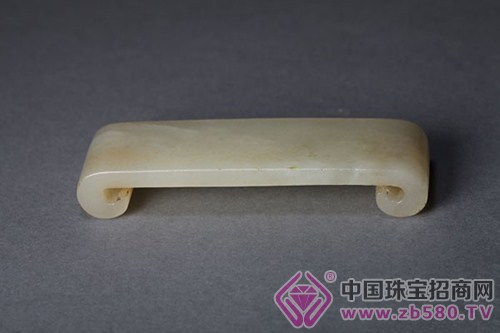Before Y Jun took a white jade ink bed in Japan. The size of the lot is 6.2 cm long, 4.9 cm wide and 0.7 cm high. The ink bed is a small device for placing ink sticks. Since the ink stick has ink on one end when it is used, in order to prevent the ink from staining the book or the paper, there is a place to be placed in the ink-filling gap, so that the appliance for temporarily placing the ink stick is named as ink because of the shape of the bed. bed. Some people think that the ink bed used as a special room has appeared in the Song and Yuan Dynasties. However, this kind of small artifact that is considered not to be later than the Song and Yuan dynasty could not be seen in the market until it was discovered in the Ming Dynasty. It was postponed to the Qing Dynasty by the history books. The ink bed of the Qing Dynasty has evolved from a simple ink-receiving tool to a work that is both practical and playable. However, this small object was clearly marked by the auction company: "Song Baiyu Shouyi æ² ink bed"! Since the ink bed appeared in the Ming Dynasty and the ink bed was recorded in the Qing Dynasty, there was suddenly a Song Dynasty ink bed appeared on the scene... Is this credible? Y Jun said that he would rather believe that this is a Song Dynasty thing. Asked about the reason, he and some of his own cognition. “This thing is very different from the Ming and Qing ink beds we know.†At present, the earliest ink beds are the Ming Dynasty artifacts. They are mostly shaped in a few cases. The lines are strong and angular, showing a graceful and elegant style. In addition to jade in this period, there are also wood-embedded jade and copper ink beds, but the handed down products are extremely rare. In the Qing Dynasty, Wenfang Ya has become fashionable, with varied styles and numerous materials. However, since the ink bed is used for placing ink ingots, it is usually not too big. It is generally considered to be wider than two fingers, but not longer than three inches. From the bright to the clear, the ink bed will not have much difference in the standard. Compared with the ink bed of the Ming and Qing Dynasties, although the utensils are also presented in several cases, the ratio of length to width tends to be square, and the height of less than centimeters is quite different from that of the Ming and Qing dynasty. Although it is not as high as the Ming and Qing dynasty ink beds, Keeping the objects close to the desktop is more stable. The most interesting thing is that during the Qing Emperor Qianlong period, the cabinets, including the ink bed, began to be widely used and widely popular. The material used for the ink bed has also evolved from bronze and jade to rosewood, ceramics, lacquerware, amber, agate, jade, and cloisonne. The shape of the ink bed is also more enriched, or tortuous, or concise, in addition to a few cases, there are also seat-shaped, book-shaped, Bogu-shaped and so on. But despite the ever-changing materials and shapes, you can't escape a simple formula: the length is often more than double the width. So, we found a great distance in the style - one long side, one high one short one. It seems that there is not much difference, but it is an insurmountable gap in the times. It is the difference between the aesthetics of the times and the functions of the times. Wool Felt Hats,Ladies' Casual Hat,Ladies' Formal Hats,Cloche Women Hat SHAOXING YONGJING FASHION HATS & ACCESSORY CO.,LTD. , https://www.yongjingchurchhat.com
September 04, 2022